Modeling a Simple Coffee Cup
"The easy path to 3D graphics"
Note: It is strongly recommended that you read the Documentation to Active Dimensions 3 before attempting to follow the tutorial.
In this tutorial we are using Active Dimensions 3 version 1.0, so your window will look slightly different.
In this tutorial we will show you how to model a simple coffee cup.
- Start Active Dimensions 3.
- Click the button that categorizes the cylinders. Select Softest Cylinder from the menu. A cylinder with very rounded edges will appear in the left of the scene.
- Press the left mouse button on the right arrow on the Dynamic Transformation Control, as shown below, and drag the mouse to the right. The cylinder will be translated to the right. Release the left mouse button when you have moved the cylinder to the approximate center of the scene.

- Click the button that categorizes the toruses. Select Torus - Small Pipe from the menu. A torus will appear in the left of the scene.
- Using the DTC, rotate the torus so that it is facing you as shown below. In order to do so, press and hold the left mouse button on the ring shown below to rotate the torus in one direction. If you need to rotate the torus in the opposite direction, use the right mouse button. To increase the speed of rotation, drag the mouse horizontally, in either direction, away from the mouse-down location.

- Click the Translate button. Using the left mouse button, click and drag the torus so that it is positioned as shown below. Release the left mouse button.

- Click the Scale button. Press the left mouse button on the torus and drag the mouse to the left so that the torus is uniformly scaled to the size shown below. Release the left mouse button.

- Press the right mouse button on the right arrow on the DTC and drag the mouse to the left so that the torus takes the shape shown below. Release the right mouse button.
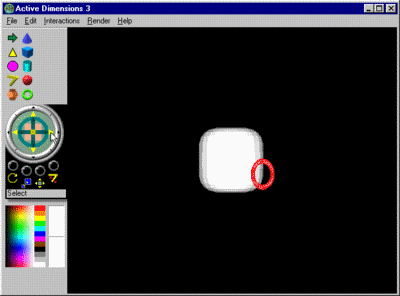
- Using the DTC, rotate the torus so that it is oriented as shown below. In order to do so, click and hold the right mouse button on the ring shown below to rotate the torus in one direction. If you need to rotate the torus in the opposite direction, use the left mouse button. To increase the speed of rotation, drag the mouse horizontally, in either direction, away from the mouse-down location.
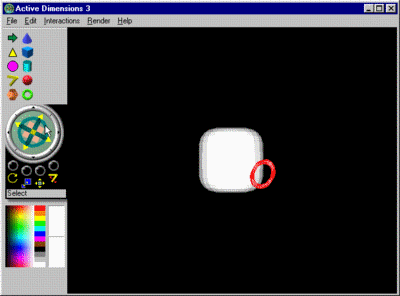
- Click the button that categorizes the cubes. Select Cube from the menu. A cube will appear in the left of the scene.
- Click the Translate button. Using the left mouse button, click and drag the cube so that it is positioned as shown below. Release the left mouse button.
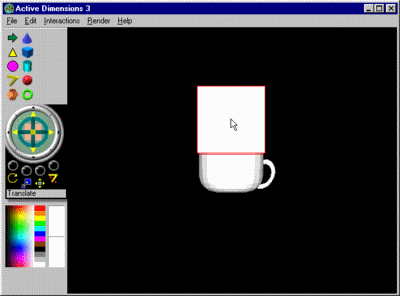
- Click the Scale button. Press the left mouse button on the cube and drag the mouse to the right so that the cube is uniformly scaled to a slightly larger size as shown below. Exact sizing of the cube is not necessary. Just be sure that your cube is wider than the cylinder. Release the left mouse button.
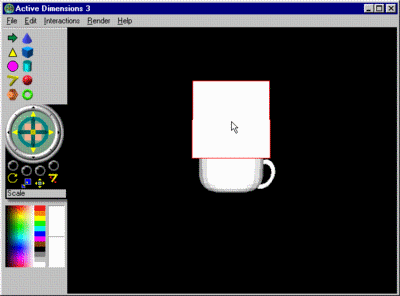
- Right-click the cylinder and select Boolean Difference (A - B): Select Operand B from the context menu. In order for the context menu to appear, you must right-click the cylinder without moving the mouse. Click the cube to subtract it from the cylinder. The bottom half of the cylinder will be left.

- Right-click the partial cylinder and select Duplicate from the context menu. In order for the context menu to appear, you must right-click the partial cylinder without moving the mouse. The partial cylinder will be duplicated with the duplicate partial cylinder coinciding with the original partial cylinder.
- Click the left mouse button on the top arrow of the DTC and drag the mouse upwards as shown below. The duplicate partial cylinder will be translated upwards. Release the left mouse button.

- Click the Scale button. Click the left mouse button on the upper portion of the duplicate partial cylinder and drag the mouse to the left to uniformly scale the duplicate partial cylinder to a slightly smaller size as shown below. You must click the left mouse button on the upper portion of the duplicate partial cylinder to avoid selecting the original partial cylinder.
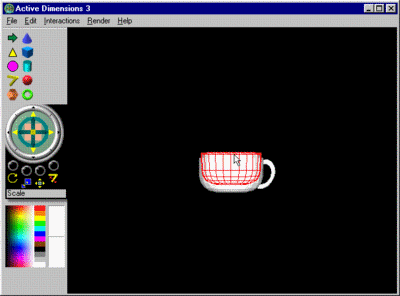
- Press the right mouse button on the bottom arrow on the DTC and drag the mouse downwards so that the duplicate partial cylinder takes the shape shown below. Release the right mouse button.
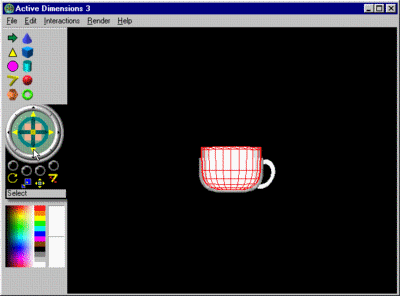
- Right-click the original partial cylinder and select Boolean Union (A + B): Select Operand B from the context menu. In order for the context menu to appear, you must right-click the partial cylinder without moving the mouse. Click the torus to unite it to the original partial cylinder.
- Right-click the original partial cylinder and select Boolean Difference (A - B): Select Operand B from the context menu. In order for the context menu to appear, you must right-click the original partial cylinder without moving the mouse. Click the duplicate partial cylinder to subtract it from the original partial cylinder.
- Now that the basic coffee cup is complete you can experiment on your own to scale the cup to a larger size, change its color, rotate it to an arbitrary viewing angle, reposition the light, and even paint a simple design on it. Remember that phong shading should be used to finally render your model.
|











